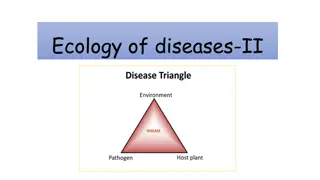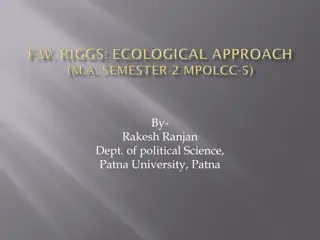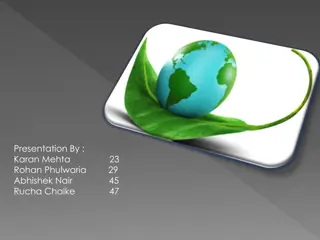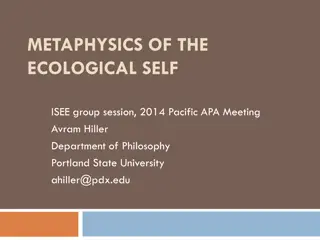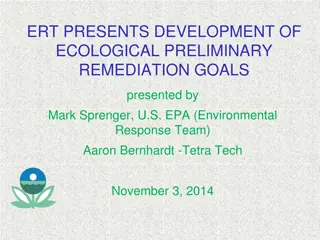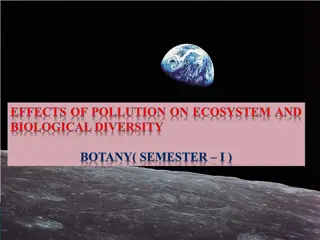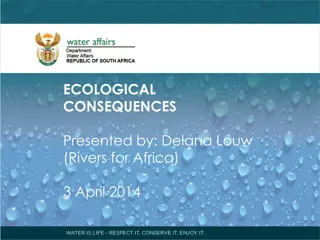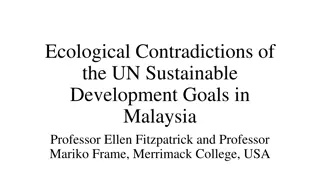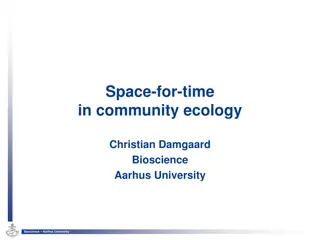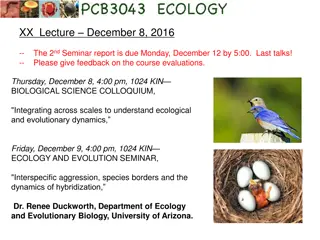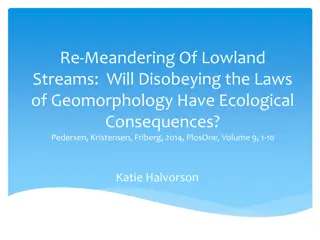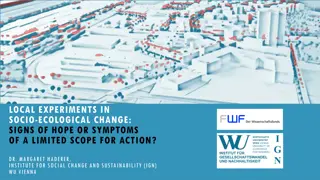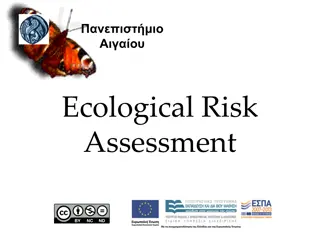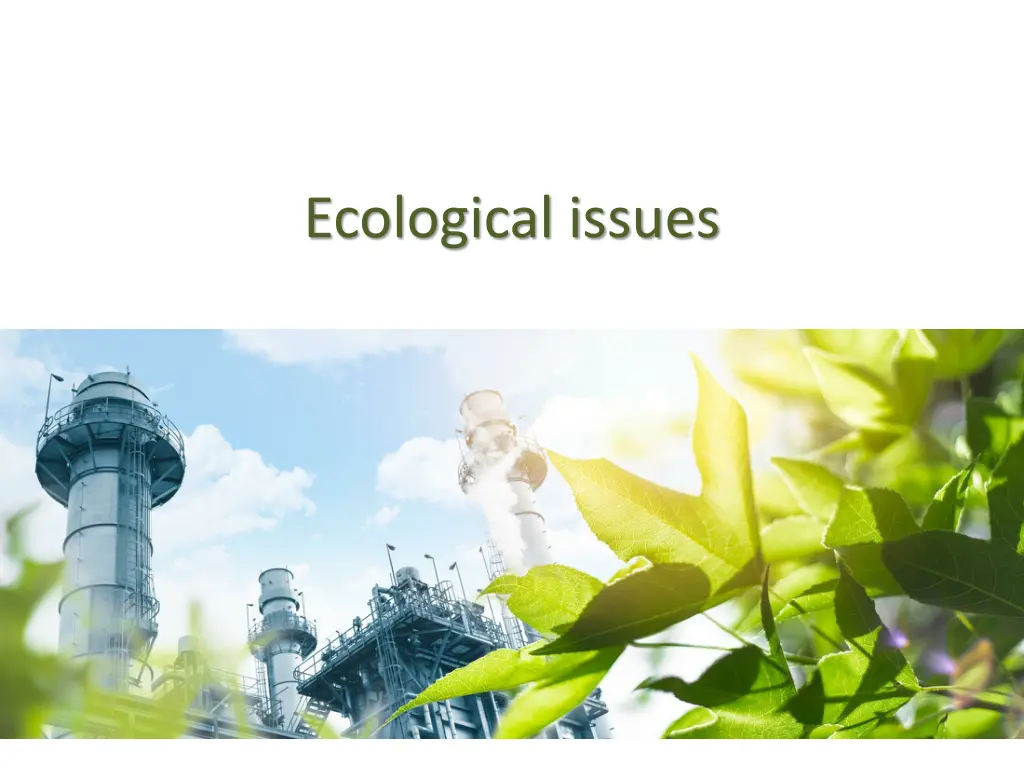
Impact of Chemical Manufacturing on the Environment
Chemical manufacturing has significant environmental impacts, including air pollution, greenhouse gas emissions, water pollution, and soil contamination. Strategies to reduce these impacts include using renewable energy sources, optimizing manufacturing processes, and implementing regulatory controls. It is essential for the industry to adopt sustainable practices to mitigate its environmental footprint.
Download Presentation

Please find below an Image/Link to download the presentation.
The content on the website is provided AS IS for your information and personal use only. It may not be sold, licensed, or shared on other websites without obtaining consent from the author. If you encounter any issues during the download, it is possible that the publisher has removed the file from their server.
You are allowed to download the files provided on this website for personal or commercial use, subject to the condition that they are used lawfully. All files are the property of their respective owners.
The content on the website is provided AS IS for your information and personal use only. It may not be sold, licensed, or shared on other websites without obtaining consent from the author.
E N D
Presentation Transcript
Ecological problems Climate Change (Global Warming) ( ) Melting Ice Caps and Sea Level Rise Loss of Biodiversity (species extinction) ( ) Air and water Pollution Plastic Pollution Agricultural Pollution Deforestation Ocean Acidification Soil Degradation Food and Water Insecurity Food Waste ( ) Fast Fashion and Textile Waste Resource Depletion
The impact of chemical manufacturing on the environment 1. Air pollution Chemical manufacturing can contribute to air pollution through the release of various pollutants into the atmosphere. These pollutants can include volatile organic compounds (VOCs) and particulate matter (PM), which can contribute to the formation of smog and ground-level ozone, as well as particulate matter, nitrogen oxides, and sulfur dioxide, which can contribute to respiratory and cardiovascular problems. Technological strategies: 1. using renewable energy sources. 2. using less harmful chemicals and optimizing manufacturing processes to reduce waste and emissions. 3. use of real-time monitoring systems.
The impact of chemical manufacturing on the environment 2. Greenhouse gas emissions Chemical manufacturing is also a significant contributor to greenhouse gas emissions, which contribute to climate change. Chemical manufacturing can produce greenhouse gases directly through the use of fossil fuels for energy and indirectly through the release of carbon dioxide during the production of chemicals. Reducing the impact strategies: Improving energy efficiency Renewable energy Renewable or recycled raw materials Carbon capture and storage (CCS) technologies designing products that have a longer lifespan or can be easily recycled Sustainable transportation: electric vehicles or biofuels The adoption of a circular economy model, where materials and products are reused and recycled
The impact of chemical manufacturing on the environment 3. Water pollution Chemical manufacturing can also contribute to water pollution through the release of pollutants into waterways. These pollutants can include toxic chemicals, heavy metals, and other contaminants that can harm aquatic ecosystems and human health. Reducing the impact strategies: Best management practices to minimize the risk of spills and leaks: regular maintenance and inspection of equipment, training for employees on safe handling practices, and emergency response plans in the event of a spill. Wastewater treatment: activated carbon filtration, reverse osmosis, and other processes. Chemical substitution: use of non-toxic solvents, safer surfactants, and other alternatives. Regulatory controls: discharge permits, effluent limits, and other requirements.
The impact of chemical manufacturing on the environment 4. Soil contamination Chemical manufacturing can also contribute to soil contamination through the release of chemicals and other pollutants into the soil. These pollutants can harm soil quality and reduce soil productivity, which can have negative impacts on agriculture and other land uses. Reducing the impact strategies: Pollution prevention:proper handling and storage of chemicals, the use of less toxic chemicals Remediation: excavation and removal of contaminated soil, in-situ treatment using chemical or biological methods, and the use of phytoremediation. Regular soil quality monitoring. Regulatory measures. Sustainable manufacturing practices.
The impact of chemical manufacturing on the environment 5. Depletion of natural resources Chemical manufacturing can contribute to the depletion of natural resources through the use of non-renewable resources, such as fossil fuels and minerals, in the production of chemicals. This can have negative impacts on the availability and quality of these resources for future generations. Reducing the impact strategies: Resource efficiency use of bio-based feedstocks or recycled materials Renewable energy Circular economy
Circular economy The circular economy is a model of production and consumption, which involves sharing, leasing, reusing, repairing, refurbishing and recycling existing materials and products as long as possible. In this way, the life cycle of products is extended.
Strategies for addressing the impact of chemical manufacturing on the environment Cleaner production methods Cleaner production methods involve the use of technologies and processes that minimize the generation of waste and the release of pollutants into the environment. This can include the use of closed-loop systems to minimize waste generation and the implementation of process optimization and energy efficiency measures to reduce the environmental impact of chemical manufacturing. Safer chemicals The development and use of safer chemicals can also help to reduce the impact of chemical manufacturing on the environment. This can include the use of green chemistry principles to design and produce chemicals that are less toxic and more environmentally friendly.
Strategies for addressing the impact of chemical manufacturing on the environment Pollution prevention and waste minimization Pollution prevention and waste minimization programs can also help to reduce the impact of chemical manufacturing on the environment. These programs can include the implementation of best management practices to prevent spills and leaks, the use of advanced wastewater treatment technologies, and the implementation of waste reduction and recycling programs. Renewable energy sources The use of renewable energy sources, such as solar, wind, and hydropower, can also help to reduce the impact of chemical manufacturing on the environment by reducing the industry's reliance on fossil fuels.
Strategies for addressing the impact of chemical manufacturing on the environment Sustainable resource management The adoption of sustainable resource management practices, such as the use of sustainable forestry practices and the implementation of sustainable water management programs, can help to reduce the impact of chemical manufacturing on the environment by promoting the responsible use of natural resources.
Task Read two articles about modern ecological problems: https://earth.org/the-biggest-environmental-problems-of-our- lifetime/ https://www.edengreen.com/blog-collection/environmental- problems Choose one topic and write short essay. In your work describe chosen problem, express your opinion on it, and think about possible ways to solve the problem.


